Hue is one of the cities with the most unique historical and cultural heritages in Vietnam, among which the Hue Royal Tombs of the Nguyen emperors cannot be overlooked. The Hue Royal Tombs were built from the 19th century and were used as the burial and worshiping places for the Nguyen Dynasty kings. These are unique architectural works that combine Vietnamese traditional style with classical French architecture. In this article, Danang Private Car’s will introduce you to the 7 most famous Hue Royal Tomb complexes today.
Table of Contents
Introduction to the Hue Royal Tombs.
Hue Royal Tombs is a unique religious and cultural architectural work of Vietnam located in the city of Hue, Thua Thien – Hue province. Built in the 19th century, the Hue Royal Tombs were the burial place of the Nguyen Dynasty emperors. The tomb complexes are often located in the Hue Imperial City Heritage Site, which is strictly preserved. In 1993, the Hue Royal Tombs were recognized as a World Cultural Heritage by UNESCO.
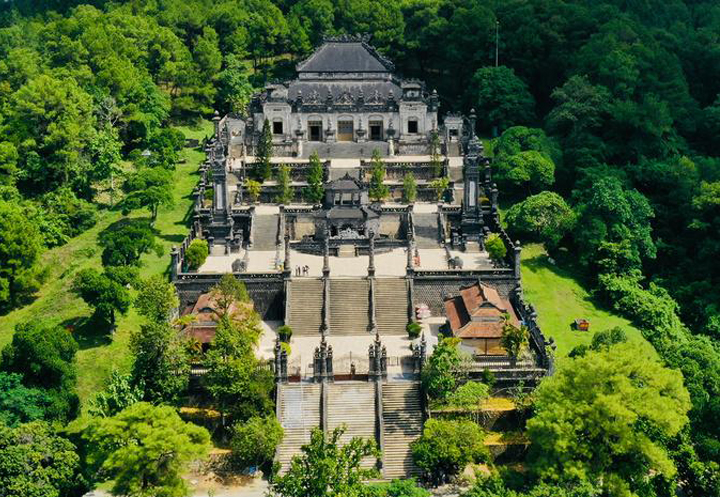
Hue is not only a historical tourist destination, but also a place where Vietnamese culture and traditions are preserved, especially during the annual festivals held at the Hue Royal Tombs. Specifically, the Hue Royal Tombs are divided into three main areas: Khuê Văn Các, Minh Đức Hiệu, and Thái Hòa Điện.
Each area has different functions, for example, Khue Van Cac is the place for altars, worship statues, and storing sacred objects of the Nguyen emperors. Minh Duc Hieu is the place where the tombstones and engraved name tablets of the emperors are placed. Finally, Thai Hoa Palace is the main courtyard where worship ceremonies and enthronement ceremonies of the emperors are held.
If you are in Da Nang city and want to go to Hue to explore the tombs there, you can book a trip from Da Nang to Hue with our private car service.
Overview of Royal Tombs in Hue.
The Royal Tombs in Hue are known as a unique system of architectural works located on both sides of the Perfume River. Although the Nguyen Dynasty had 13 kings, there are currently only 7 royal tombs in Hue, namely the tombs of King Tu Duc, King Minh Mang, King Khai Dinh, King Gia Long, King Duc Duc, King Thieu Tri, and King Dong Khanh.
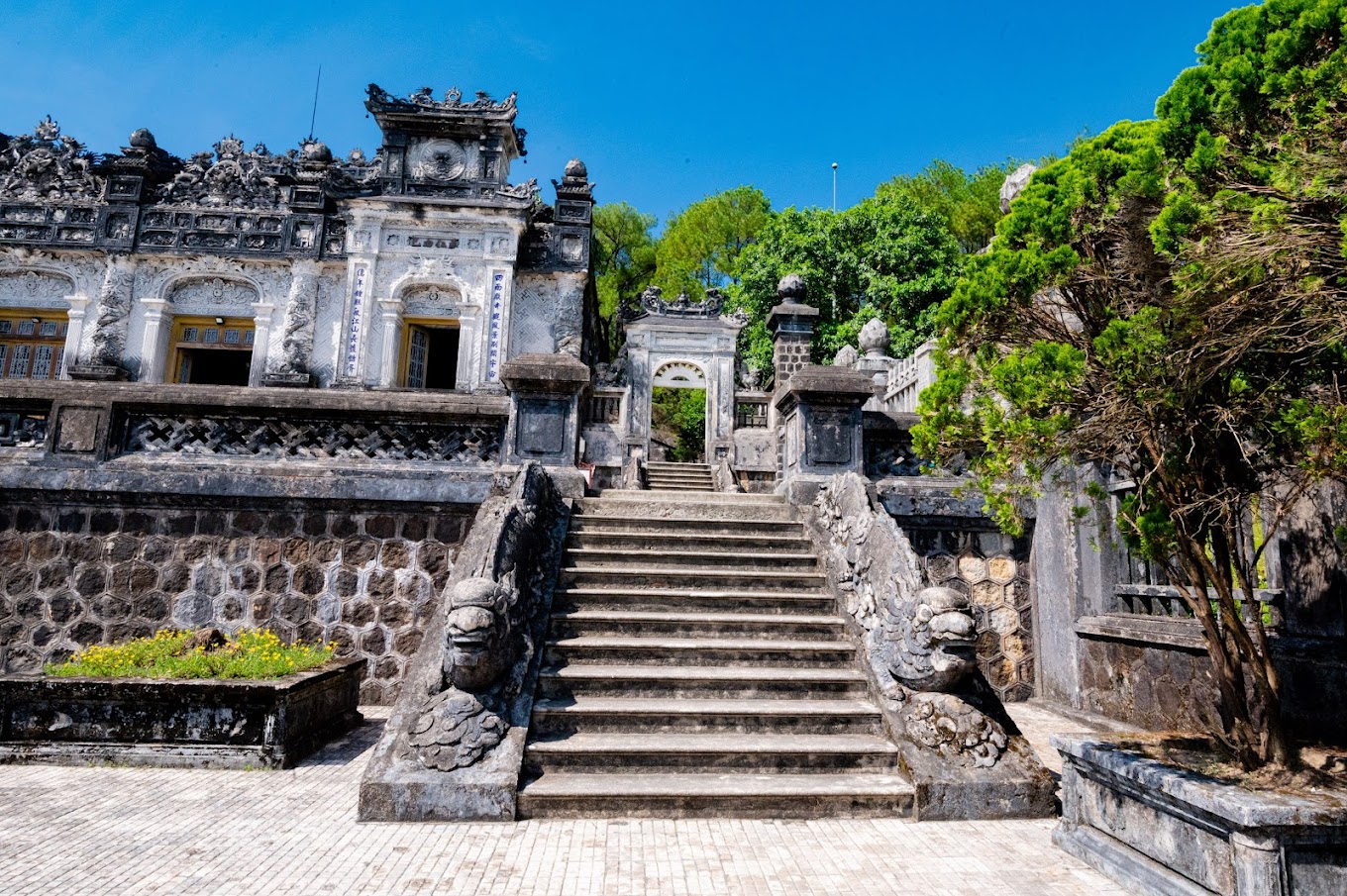
These tombs are built in a classical style, not only carrying the royal architecture of Vietnam but also exquisitely blending with elements of Eastern and Western cultures. Each tomb has a spacious courtyard surrounded by grand walls. Upon entering, visitors can admire buildings, palaces, bridges, tombs, temples, and shrines.
Among these tombs, the Tomb of Tu Duc is considered one of the most remarkable architectural works thanks to its perfect design and color scheme. Therefore, visitors should not miss the chance to explore these Royal Tombs in Hue in order to discover the unique culture and history along with the splendid architectural masterpieces in Vietnam.
History and significance of the Royal Tombs in Hue.
Each Royal Tomb in Hue is associated with an inspiring and interesting historical story. These tombs were built in the early period of the Nguyen Dynasty when King Gia Long moved the capital from Phu Xuan (now Hue) to Thang Long (now Hanoi) in 1802 to establish Dai Nam. Since then, the kings of the Nguyen Dynasty built these tombs to bury themselves and their royal family members.
The Royal Tombs in Hue not only serve as the resting places of the emperors of the Nguyen Dynasty, but also play an important role in preserving the historical traces, cultural heritage, and unique architecture of Vietnam. Moreover, the preservation and development of the Royal Tombs in Hue contribute to the conservation and enhancement of the cultural heritage value of the country, aiming to attract tourists to boost the economic and cultural value of the region.
Furthermore, these tombs also play a significant role in rituals and religion. The Royal Tombs in Hue are often considered as sacred places and temples where people can come to remember and pray for the kings and officials who once ruled the country.
Exploring the architecture of King Minh Mang’s Tomb.
King Minh Mang’s Tomb in Hue is considered one of the largest tombs under the Nguyen Dynasty. Located about 12 km west of the city center, on Cam Ke Mountain in Huong Tho – Huong Tra commune, Thua Thien Hue province.
The architecture of King Minh Mang’s Tomb reflects a combination of Vietnamese and Chinese architectural elements. The tomb was built on a land area of more than 18 hectares, including buildings, lakes, gardens, and paths. Notably, the main gate, built from black stone, is decorated with exquisite carvings.

With a system of 50 large and small architectural structures, King Minh Mang’s Tomb is designed along a straight axis, extremely symmetrical. First, visitors will come to Dai Hong Mon, the main gate to enter the tomb, with two side gates, Ta Hong Mon and Huu Hong Mon. Further inside is the final resting place of King Minh Mang.
The cultural history of the Tomb of Emperor Tu Duc:
The Tomb of Emperor Tu Duc is the resting place of Emperor Tu Duc, the last emperor of the Nguyen dynasty and the longest-reigning emperor (from 1848 to 1883) in the country’s history. At the same time, this tomb is also considered the most romantic and poetic one in Hue’s imperial city.
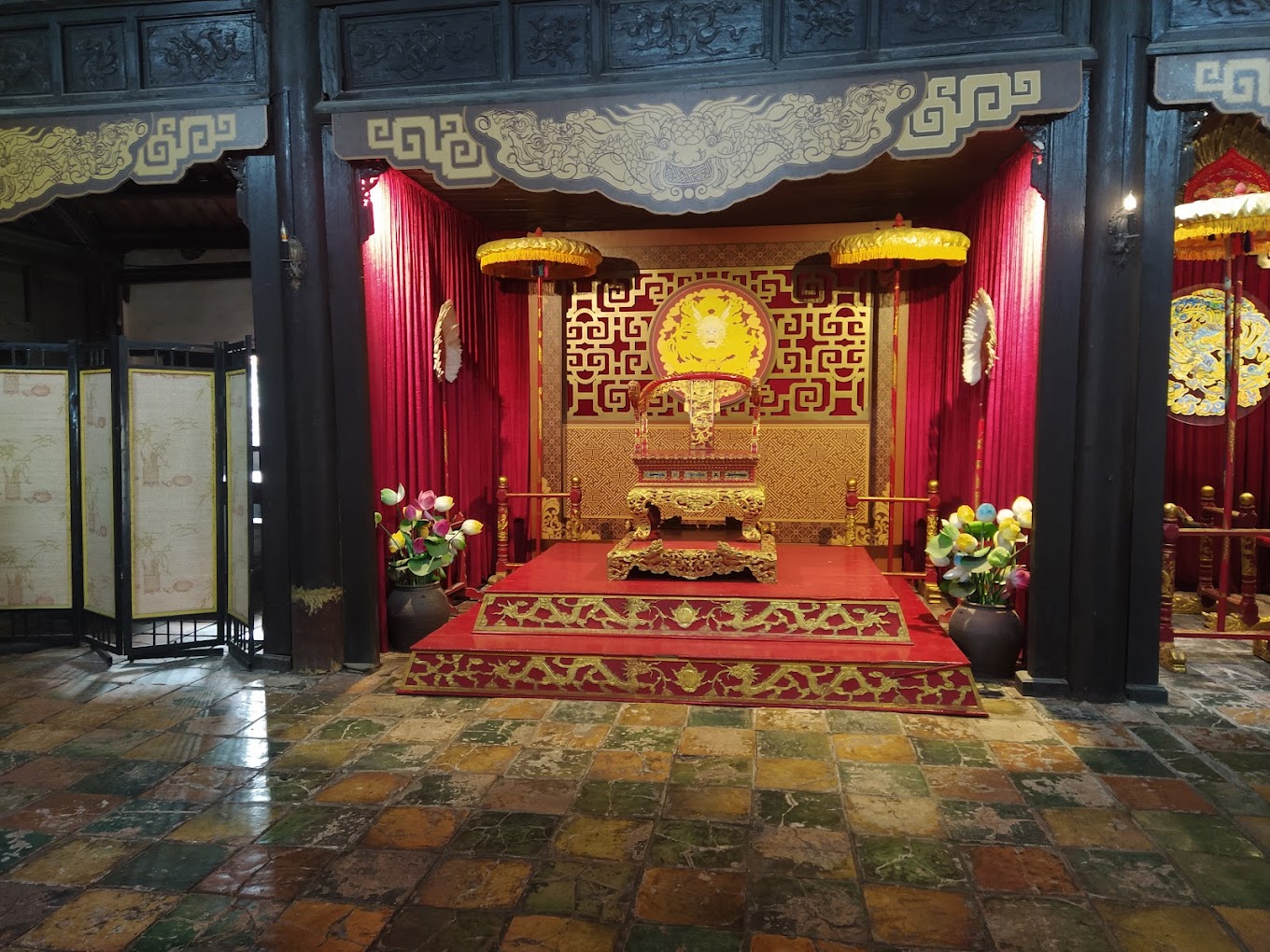
Like other tombs, the Tomb of Emperor Tu Duc consists of 50 large and small architectural structures, starting from Vu Khiem Gate, Khiem Cung Gate, then to the Hoa Khiem Palace, Luong Khiem Palace, On Khiem Palace, and ending with the emperor’s burial site. The space of this Hue tomb is covered by a system of cool green trees, and there is also a large lotus lake where tourists can take photos.
Because the emperor had an artistic soul, he planned, designed, and built the entire tomb himself. When you come here, you not only feel the solemn and majestic appearance of the emperor but also faintly perceive the romantic and poetic scenery, creating a sense of peace and relaxation.
Ancient check-in at the tomb of King Khai Dinh.
Perhaps the first impression that many people remember when mentioning the Khai Dinh royal tomb is the intricate architecture that cleverly combines classic Eastern and modern Western styles. This is the tomb of the 12th emperor of the Nguyen dynasty, King Khai Dinh, which took 11 years to build. The Khai Dinh tomb is located on Chau Chu Mountain, Thuy Bang commune, Huong Thuy district, Thua Thien Hue province.
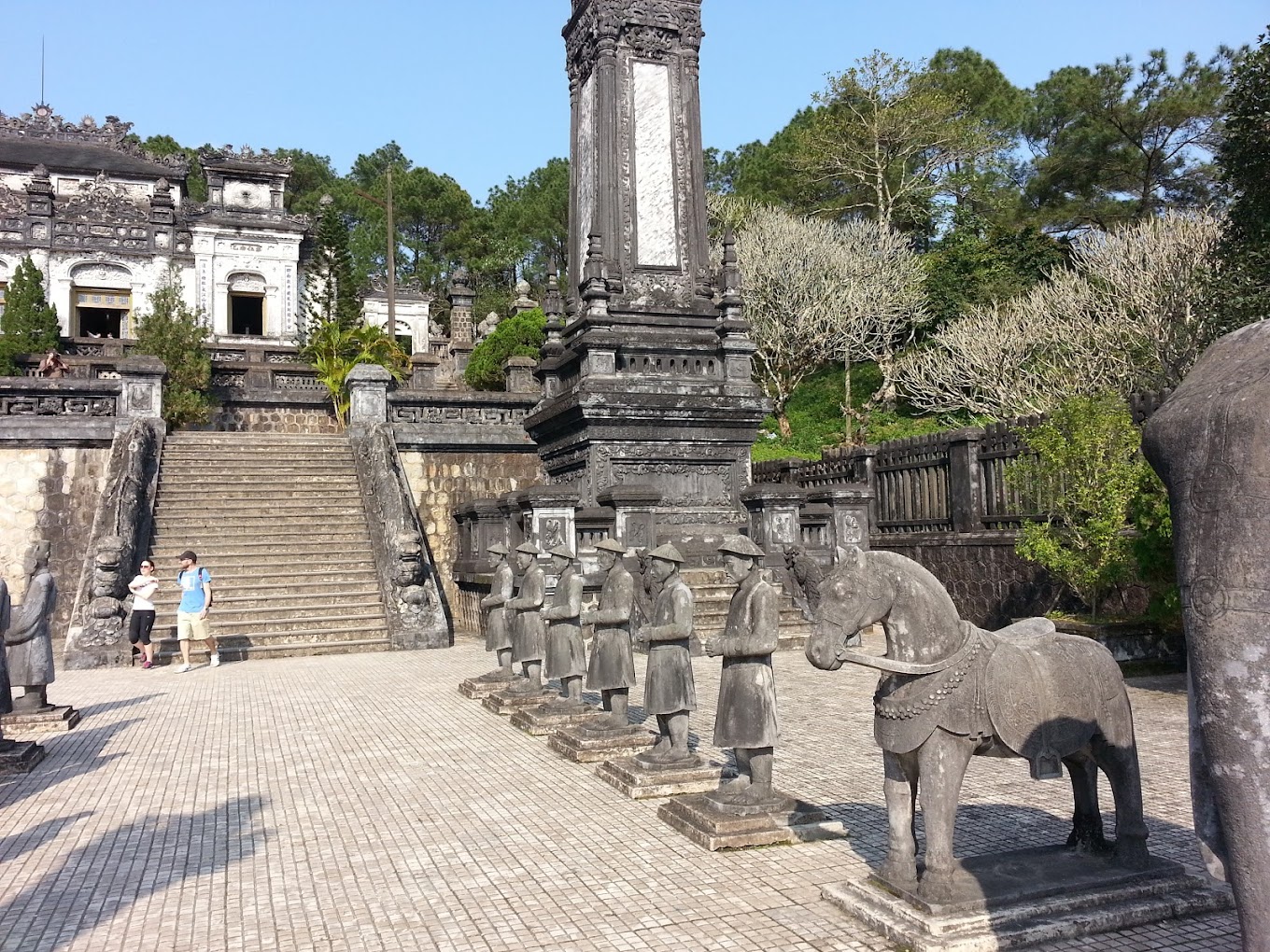
From the outside, the Hue Khai Dinh tomb looks quite old with traces of time, but it still maintains its solemn and dignified appearance in its architectural style. The highlight of this tomb complex is the large staircase system, consisting of 127 steps with three adjacent flights of stairs. The outer walls are designed in the shape of crosses combined with curved arches, which are characteristic of Roman art and add to the mysterious beauty of the Khai Dinh tomb.
Upon entering, visitors can admire the magnificent and luxurious interior, completely different from the exterior. The interior of the Khai Dinh tomb has been completely renovated, with the brick walls, wall paint colors, and patterns all fully restored. In addition, this Hue tomb still displays valuable artifacts, including the “Nine Dragons” painting.
Admiring the beauty of the Nguyen dynasty at Gia Long Mausoleum
With a large area, Gia Long Mausoleum is also one of the longest construction projects, lasting up to 6 years. In addition to the name Gia Long, this mausoleum is also known as Thien Tho Lang. Located in the prime position of Dai Thien Tho mountain range, surrounded by majestic mountains and vast nature, the solemn and majestic appearance of the first king of the Nguyen dynasty is evoked.
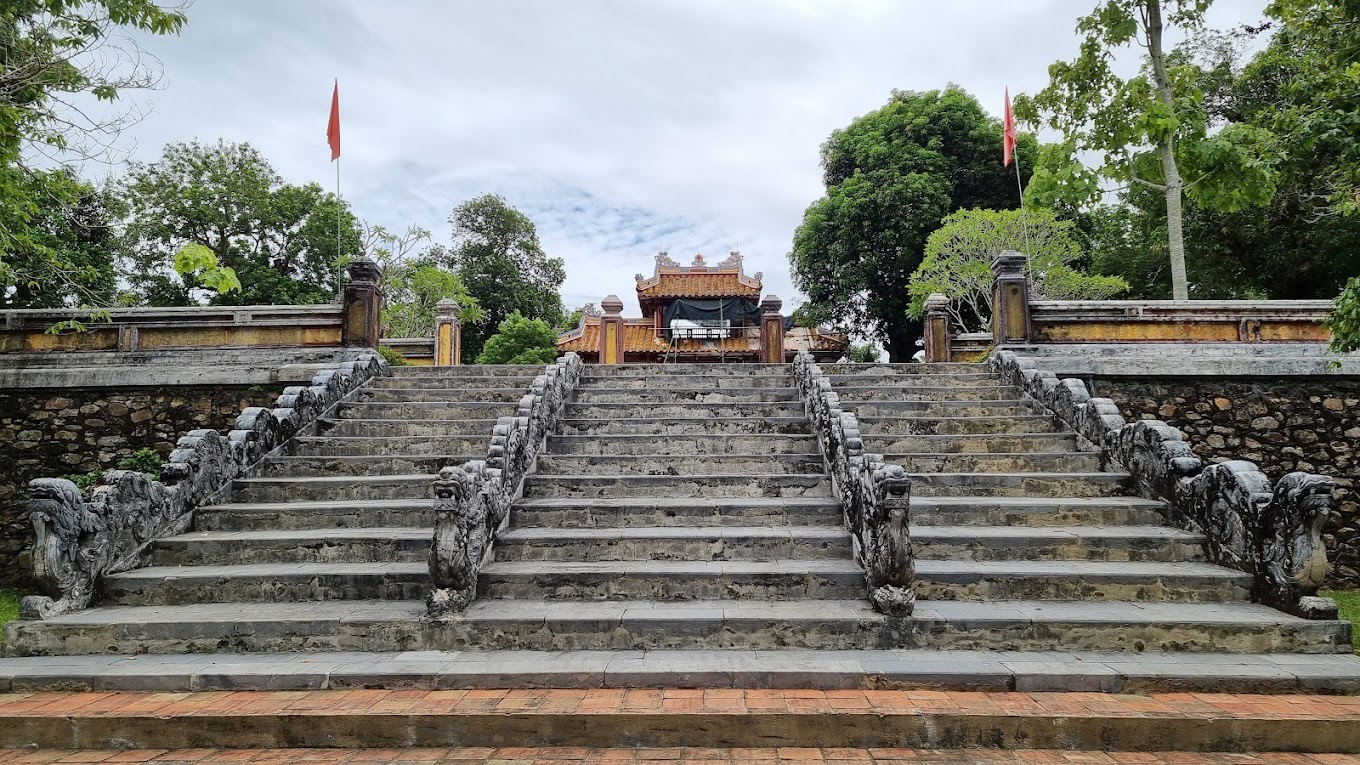
The entire mausoleum area is divided into 3 different areas. Specifically, the central location is the tomb of the king and queen, to the right is the Minh Thanh Palace – where the previous kings and queens are worshipped, and the left area is where the large stele carved by King Minh Mang is displayed, with each character engraved separately.
Surrounding the main mausoleum area are many adjacent auxiliary tombs and a system of shady trees. All of these objects combine perfectly to create a solemn and antique yet affectionate whole.
Visiting the Tomb of King Dong Khanh
The Tomb of King Dong Khanh is one of the famous tourist destinations in Hue, Vietnam. Located on Ham Long Hill, it is the final resting place of the 9th king of the Nguyen dynasty. With its characteristic architecture of the Hue court, the Tomb of King Dong Khanh is not only a place to commemorate the heroic king but also a popular attraction for many visitors.
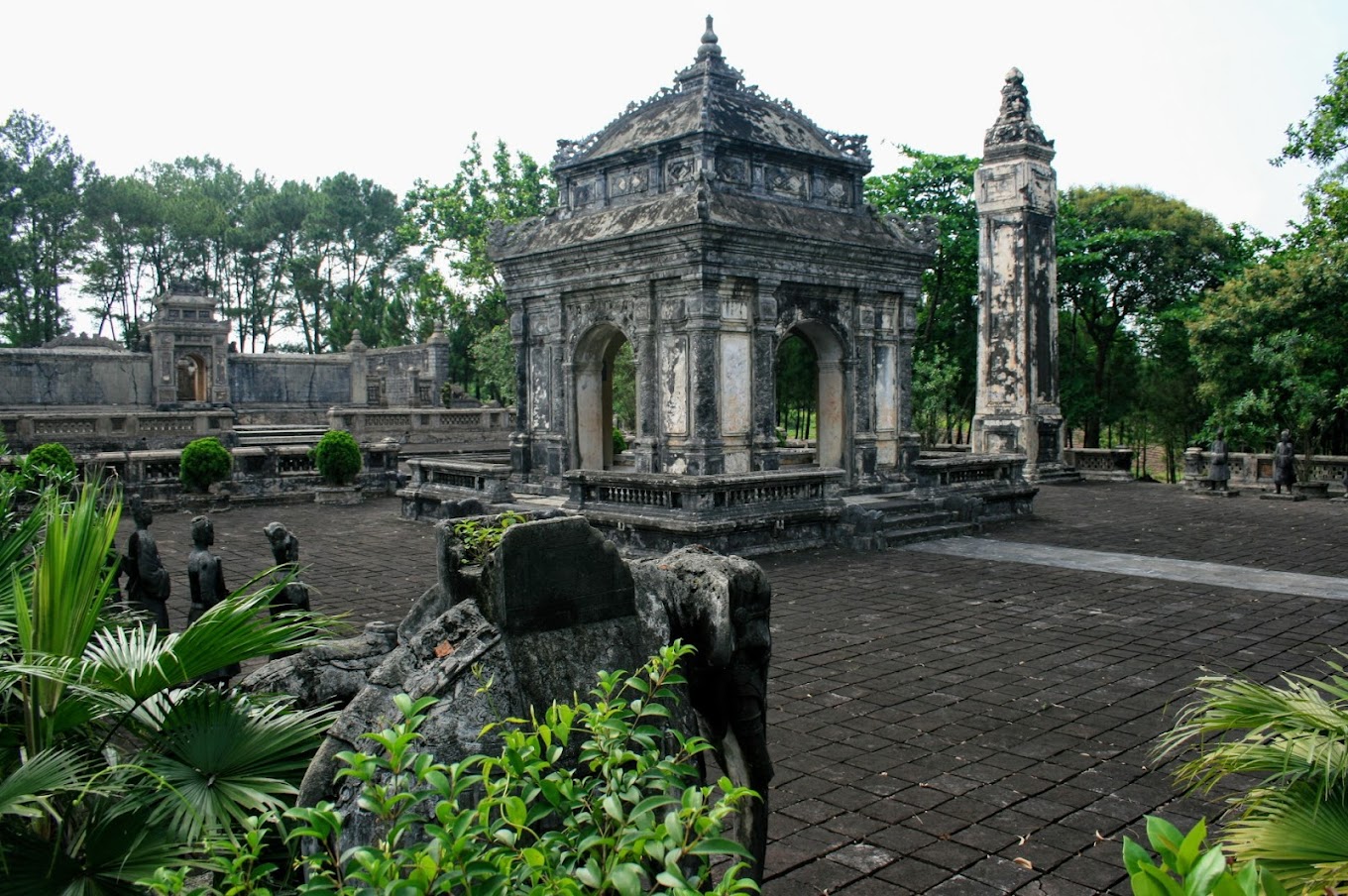
Built over 35 years, the tomb was constructed in a combination of Asian and European styles, reflecting the traditional and modern elements. This is evident in the arrangement of buildings and artworks on the site. The highlight of the Tomb of King Dong Khanh is a 3-meter tall white stone statue placed in the center.
In addition to its unique architecture, the Tomb of King Dong Khanh has historical and cultural significance. It preserves valuable documents on the history of the Hue court and Vietnam. Visitors can learn more about the history and culture of Vietnam when they visit this site.
Visit the Tomb of King Bao Dai.
The Tomb of King Bao Dai is located on Cu Thanh Hill, about 7km northwest of the city center. It is considered a symbol of Vietnamese culture, art, architecture, and history. With the distinctive architecture of the Hue dynasty, the Tomb of King Bao Dai is a beautiful and exquisite work. This Hue tomb complex was built to honor and commemorate the last king of the Nguyen dynasty. All the buildings on the Tomb’s grounds are carved, lacquered, and decorated with high-quality materials, from stone to bronze and gold.
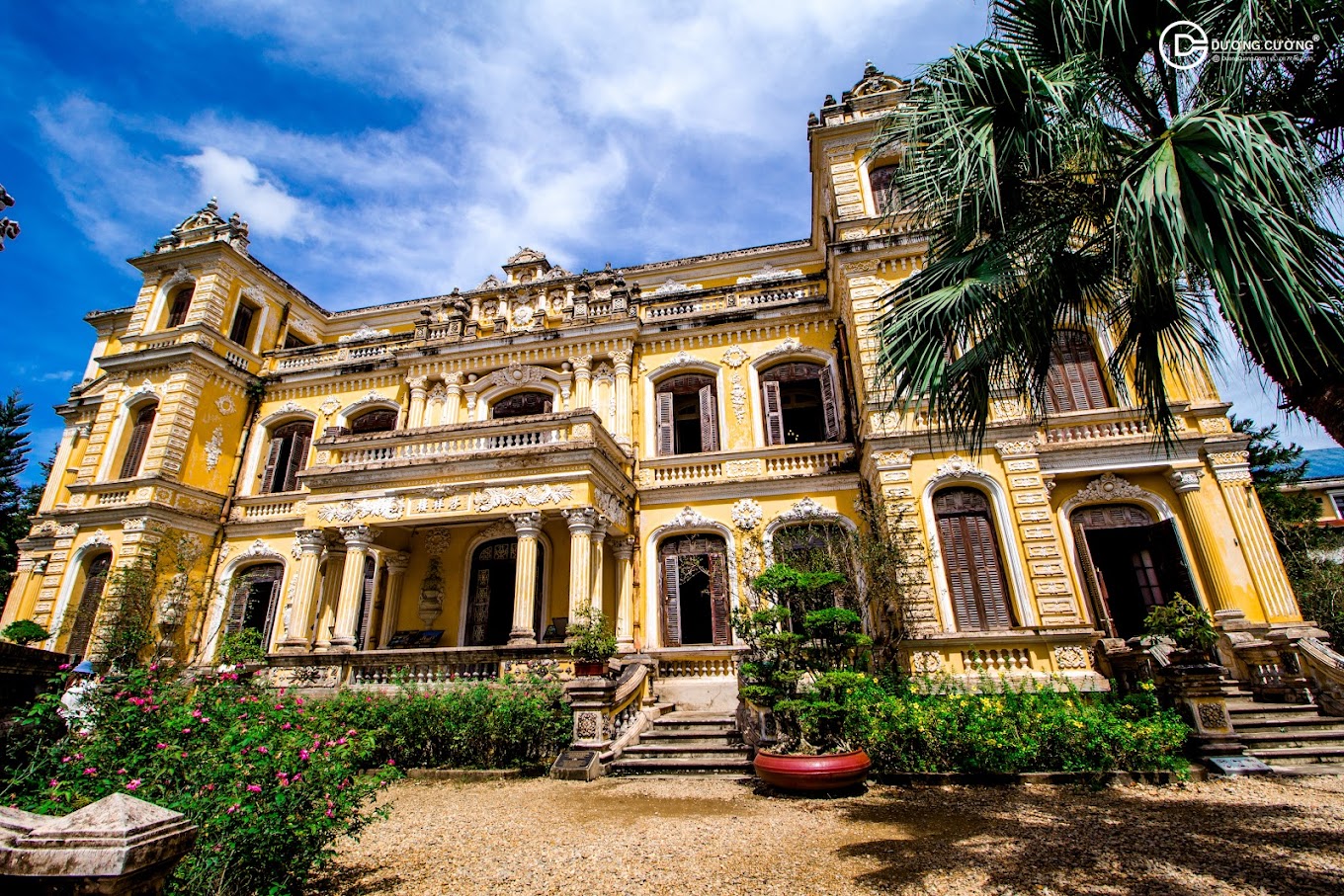
In addition to admiring the buildings and artworks, the Tomb of King Bao Dai also has significant historical value. It houses many valuable documents, images, and objects from the Nguyen dynasty. Visitors can learn more about the history, culture, and customs of Vietnam.
Enjoy the peaceful atmosphere at the tomb of King Thieu Tri.
While most of the tombs in Hue have an imposing and solemn appearance, the tomb of King Thieu Tri is quite different. Although not very large in scale, the tomb of King Thieu Tri still attracts many visitors due to its rustic and intimate atmosphere, as well as its refreshing and spacious surroundings.
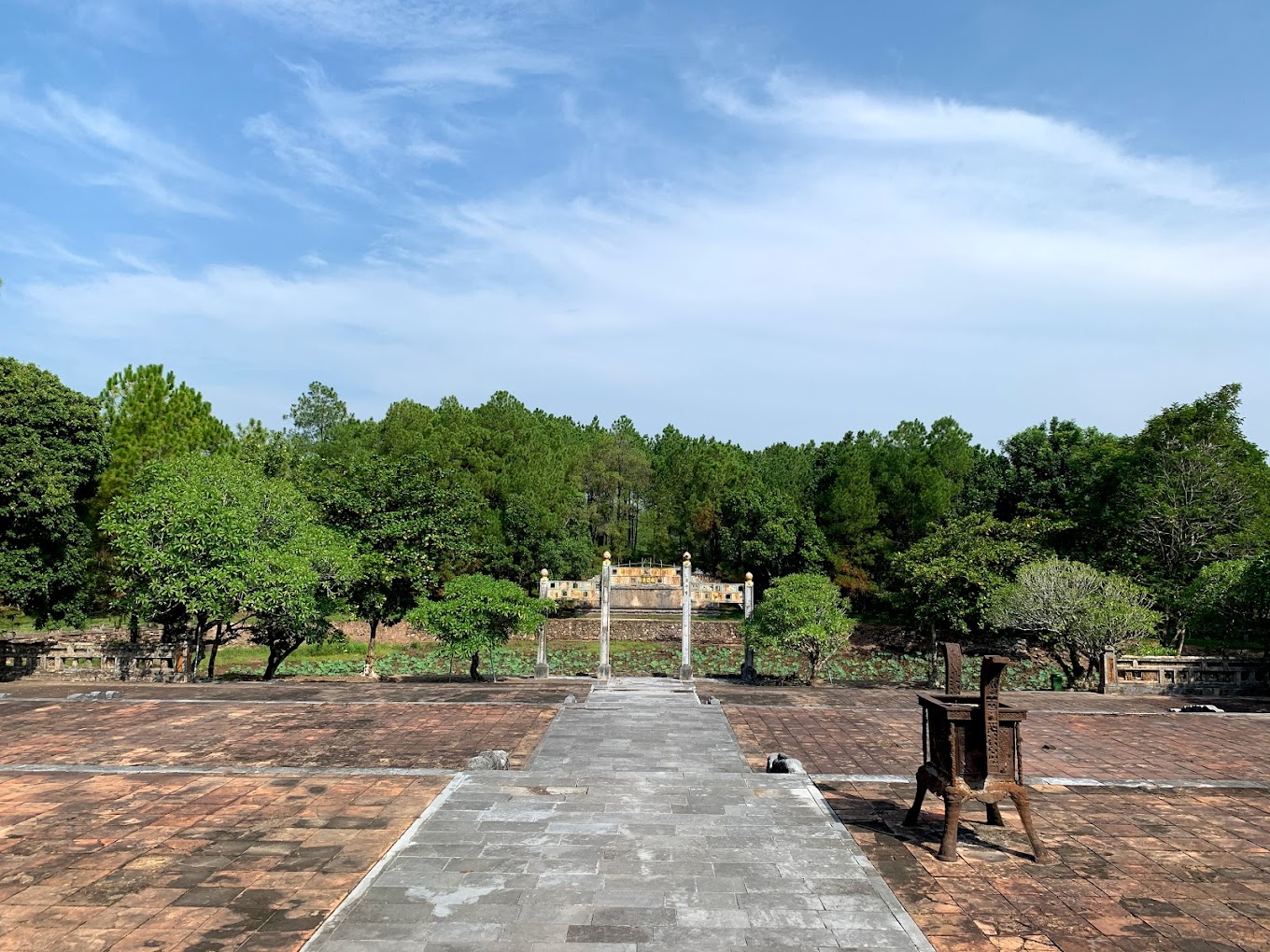
Located near Thuan Dai mountain in Cu Chanh village, Thuy Bang, Hue city, the tomb of King Thieu Tri is far from the hustle and bustle of the city center, nestled in the vast natural landscape. Despite being built in a hurry, this tomb still impresses many visitors with its beautiful and aesthetically pleasing architectural style, with intricate carvings and decorations made from gold, green stone, and red copper.
All buildings within the tomb are intricately carved, polished, and decorated with precious materials such as gold, green stone, and red copper. The artistic works within the tomb hold high historical, cultural, and artistic value. Visitors can enjoy the tranquil and peaceful atmosphere at the tomb of King Thieu Tri, making it an ideal destination for those who love art and history.
Travel experience at 7 tombs in Hue.
Above is a detailed introduction to the 7 most famous tombs in Hue. In addition, in this self-guided Hue travel guide, we will share with you some useful tips to have a memorable visit to the 7 tombs in Hue.
The best time to visit.
The best time to visit the tombs in Hue is from January to April or from September to December. This is the time when the weather in Hue is quite cool and dry, not too sunny, and rarely rainy. During these times, the scenery at the tombs is at its best, especially in the fall when the trees begin to change colors, creating extremely poetic landscapes for you to freely check-in and take pictures.
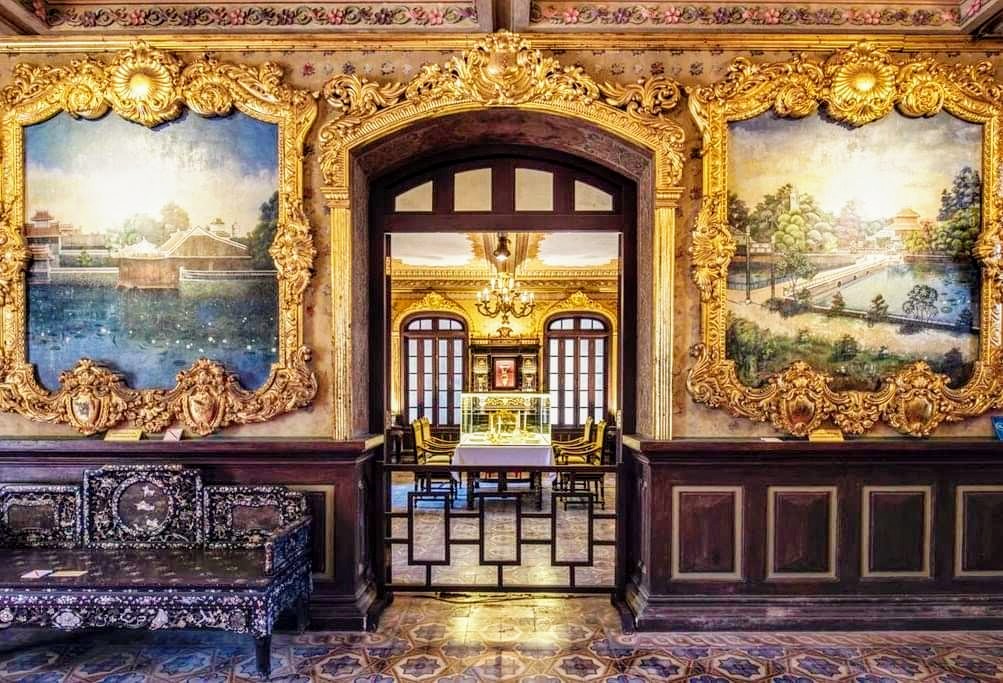
In addition, you should avoid visiting the tombs in June, July, and August. During this time, the weather in Hue is very hot and humid, not conducive to a lot of movement, and very tiring. By August, Hue starts to have heavy rain, so if you want to visit in this month, don’t forget to prepare for raincoats and umbrellas.
Ticket prices and types.
The admission fee for visiting the tombs in Hue is not too expensive, however, each type of visitor has different ticket prices. Specifically:
- Tickets for admission to the Tự Đức Tomb, Minh Mạng Tomb, and Khải Định Tomb: 150,000 VND/adult; 30,000 VND/child.
- Ticket for admission to the Đồng Khánh Tomb: 100,000 VND/person, free for children.
- Ticket for admission to the Thiệu Trị Tomb: 50,000 VND/adult, free for children.
- Ticket for admission to the Gia Long Tomb: 150,000 VND/adult, free for children.
In addition, the various tombs in Hue also offer different types of tickets at different prices for visitors, including:
- Ticket for the Minh Mạng Tomb – Gia Long Tomb route: 240,000 VND/adult, 30,000 VND/child.
- Ticket for the Tự Đức Tomb – Đồng Khánh Tomb route: 200,000 VND/adult, 30,000 VND/child.
- Ticket for the Huế Imperial City – Minh Mạng Tomb – Khải Định Tomb route: 420,000 VND/adult, 80,000 VND/child.
- Ticket for the Huế Imperial City – Minh Mạng Tomb – Tự Đức Tomb – Khải Định Tomb route: 530,000 VND/adult, 100,000 VND/child.
See More: Ticket price list for 2023 to visit Hue, Vietnam
Guidelines for visiting and getting around.
For those who are visiting Hue for the first time, we will provide you with detailed instructions on how to visit and get around the Hue’s imperial tombs:
- Visitors can travel by motorbike, bicycle, or taxi to the imperial tombs.
- If you are not familiar with the area, it is recommended to hire a guide or use Google Maps to avoid getting lost.
- Visitors should allocate at least one day to visit the imperial tombs in Hue. You can start early in the morning and end in the evening.
- The most famous and beautiful imperial tombs in Hue are Tu Duc Tomb, Khai Dinh Tomb, Minh Mang Tomb, and Gia Long Tomb. Therefore, if you do not have much time, you can prioritize visiting these tombs first.
- Before visiting the imperial tombs, it is recommended to read and learn more about the history and culture of Hue and the Nguyen dynasty to better understand these heritage sites.
- Tourists should wear comfortable clothes, comfortable shoes for moving around and bring drinking water and snacks to ensure good health during the visit.
- Visitors can start from Minh Mang Tomb, then Khai Dinh Tomb, Tu Duc Tomb and end at Gia Long Tomb. The itinerary can also be adjusted depending on your time and preferences.
- If you do not want to queue and wait, you can book tickets in advance through official websites or through ticket agents.
- Note that in the imperial tombs, maintaining cleanliness, respecting cultural heritage, and not making noise are essential.
Tourism in Hue is developing rapidly and is not inferior to any other city. Along with that, famous tourist destinations such as the Hue Imperial City, palaces, and Hue’s famous mausoleums are increasingly attracting a large number of tourists. Therefore, you can refer to our Hue City Tours to save time and visit multiple attractions.
In addition, if you want to take a day trip to Hue from Da Nang, you can contact us for advice on exciting Hue City Tours From Da Nang, Hue City Tours From Hoi An at extremely affordable prices, promising to bring you great experiences on your trip.

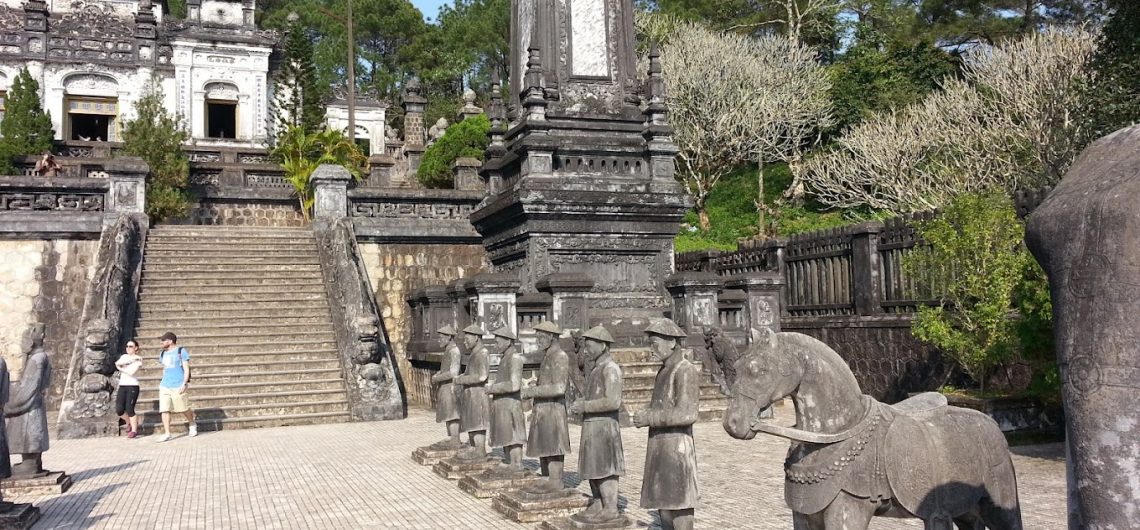
Comments